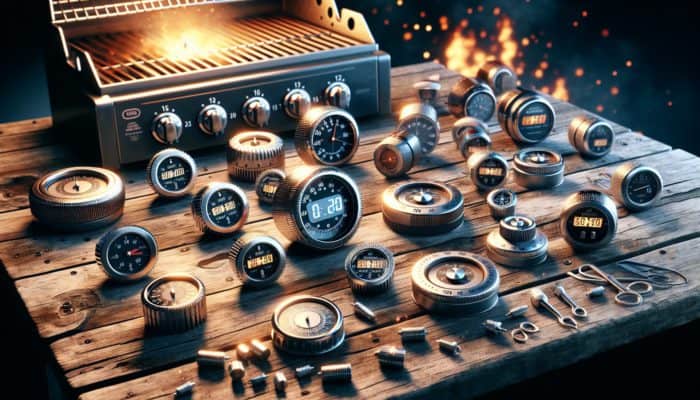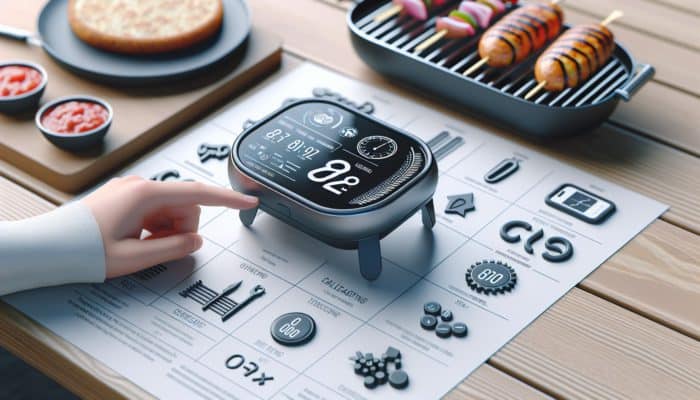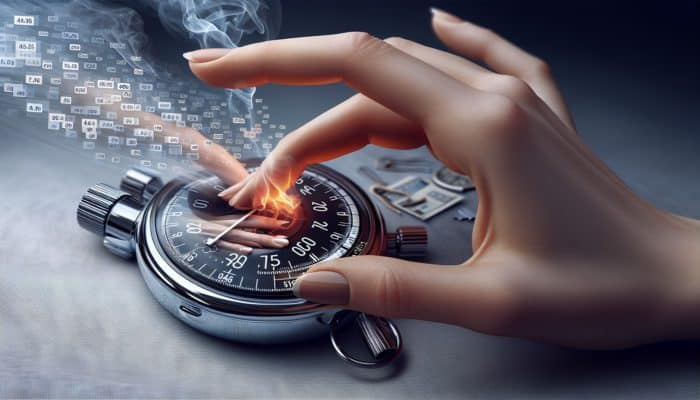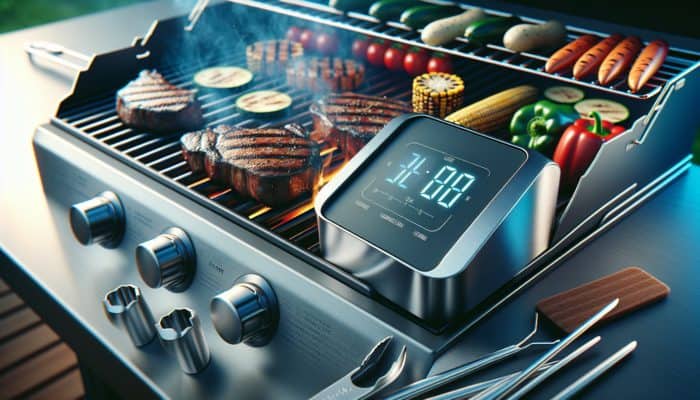Selecting the Ideal Grill Timer for Achieving Culinary Perfection
Using a Grill Timer for Perfect Results: Grilling is not merely a cooking method; it is an art that demands precision, skill, and meticulous attention to detail. Among the most vital instruments for achieving culinary excellence is a dependable grill timer. With the right timer, you can ensure that every piece of meat and vegetable reaches its optimal doneness, guaranteeing a delightful dining experience. This comprehensive guide will help you select the perfect grill timer tailored to your unique grilling needs.
Exploring the Various Types of Grill Timers

Understanding the array of timer options available is essential when choosing a grill timer. Mechanical timers are typically straightforward and user-friendly, featuring intuitive dials that allow for easy time setting. These timers are built to last, requiring no batteries, making them a reliable choice for outdoor grilling. Conversely, digital timers come equipped with advanced capabilities, including countdown timers and precise settings tailored for different food types. Many models even include magnetic backs, allowing for convenient attachment to your grill or refrigerator for quick access.
For those who embrace technology, app-based timers are becoming increasingly popular. These innovative timers link to your smartphone, offering alerts and updates on your cooking progress. With features such as temperature sensors and remote monitoring capabilities, app-based timers significantly enhance your grilling experience, allowing you to multitask without losing track of your meal.
Key Features to Evaluate When Choosing a Grill Timer
It’s important to recognize that not all grill timers offer the same features. When selecting a timer, consider essential functionalities such as countdown, count-up, and multiple alarm settings. A countdown timer is ideal for setting specific cooking times, ensuring that your steak is cooked to perfection without being overdone. Count-up timers are useful for cooking time, especially for slow-cooked dishes, such as brisket or ribs.
Having multiple alarm settings enables you to program different cooking times for various foods simultaneously. This feature is especially beneficial when grilling an assortment of meats and vegetables, ensuring that all items finish cooking at the same time. Look for timers that provide clear audio alerts, vibration options, or even visual cues to guarantee you don't miss the signal.
Listen With Me?
Affordable Grill Timer Options for Budget-Conscious Grilling Enthusiasts
Enthusiasts of grilling need not spend a fortune to find a reliable grill timer. Numerous budget-friendly options deliver dependable performance without skimping on essential features. Many high-quality mechanical and digital timers are available for under $20. While shopping for a timer, take the time to read customer reviews and consider brands that are known for their durability and accuracy. Investing in a quality timer can significantly enhance your grilling experience without stretching your budget.
Ensuring User-Friendly Operation and Simple Setup

A complicated grill timer can swiftly transform a joyful grilling experience into a source of frustration. Seek timers with user-friendly interfaces that require minimal effort to configure. Timers featuring large, easy-to-read displays and intuitive buttons will save you time and hassle while you keep an eye on your food.
Additionally, consider the timer's portability. A compact, lightweight design makes it easy to transport for tailgating or camping trips. Ensure that the timer can be quickly set up and accessed without diverting your attention from the grill, maintaining a seamless cooking experience.
Choosing a Durable and Weather-Resistant Grill Timer
Grilling often occurs outdoors, exposing your equipment to various weather conditions. Therefore, selecting a grill timer that is both durable and weather-resistant is vital. Look for timers made from robust materials that can endure the elements, such as high-quality plastics or stainless steel. Timers with water-resistant features will protect against accidental splashes or rain, ensuring your device remains functional. A reliable grill timer should be as resilient as the grilling experience itself, offering longevity and consistent performance regardless of external conditions.
Step-by-Step Guide to Setting Up Your Grill Timer for Optimal Results
Properly configuring your grill timer is crucial for achieving the best cook. This guide provides essential information. This guide offers a detailed, step-by-step approach to programming, posing various challenges for diverse types of food.
Calibrating Your Timer for Accurate Readings

Before you begin grilling, it's essential to confirm that your timer is accurately calibrated. Calibration methods may vary by model, so always refer to the manufacturer's guidelines. While many digital timers come pre-calibrated, it’s prudent to verify their accuracy. To do this, set the timer for a specific duration, such as 10 minutes, and check if it alerts you correctly. If you encounter any discrepancies, adjust the settings according to the provided instructions.
Ensuring that your timer is calibrated accurately can avert significant cooking mishaps, such as undercooking or overcooking your delicious meal. Taking the time to confirm your timer's accuracy before each grilling session will yield the best possible results.
Optimal Placement of Your Grill Timer for Maximum Efficiency
The placement of your grill timer can dramatically influence your grilling efficiency. Both the timer in A and the one that is not only easily visible but also accessible during cooking. Many grillers find it beneficial to place the timer at eye level or within arm's reach, allowing for glances without having to step away from the grill.
Consider utilizing the magnetic backs of digital timers to attach them to your grill or setting up a small stand on your prep table. Ensure that the timer is sheltered from direct heat or flames, as prolonged exposure can damage the device, compromising its functionality.
Programming Your Timer for Different Food Types
Different foods require varying cooking times, making it essential to familiarize yourself with programming your timer for each type of meat or vegetable you plan to grill. For example, chicken breasts typically need 6-8 minutes per side, whereas burgers may only require 4-6 minutes. Effectively utilizing your timer will help you achieve that perfect sear without the anxiety of burning or undercooking.
Consider creating a grilling cheat sheet that includes recommended cooking times for various foods. Keep this handy next to your grill timer for quick reference. By adhering to these time guidelines and programming your timer accordingly, you can eliminate the guesswork from grilling and focus on enjoying the outdoor cooking experience.
Mastering Timing Techniques for Various Cuts of Meat
Perfecting the timing for different types of meat can significantly enhance the overall experience. This section is designed to achieve optimal techniques aimed at achieving optimal results for various cuts of meat.
Achieving the Perfect Grill on Steaks
Grilling the ideal steak is a coveted skill that can impress any guest. The crucial factor for achieving your desired doneness—be it rare, medium, or well-done—lies in the precision of your timing. A general rule of thumb is to allocate 4-5 minutes per side for a 1-inch thick steak, but employing a grill timer can perfect this process.
For rare steaks, aim for an internal temperature of approximately 125°F, medium at 135°F, and well-done starting at 160°F. Use your grill timer to keep a close watch on the cooking duration, ensuring that you don’t overcook your meat. Additionally, consider using a meat thermometer to double-check the internal temperature, emphasizing the importance of precision in your grilling technique.
Grilling Chicken to Perfection
Grilling chicken necessitates stringent attention to cooking times, as poultry must be thoroughly cooked to prevent foodborne illnesses. Typically, chicken breasts need to be grilled for about 6-8 minutes per side, while thighs and wings may require longer, approximately 10-12 minutes.
Set your grill timer accordingly, and always verify the internal temperature. Chicken should reach a minimum of 165°F to ensure safety. To avoid dryness, consider marinating your chicken beforehand or employing a brine, which enhances flavor and moisture retention. A reliable timer guarantees your chicken is cooked perfectly while preserving its juiciness.
Perfecting the Art of Grilling Pork
Pork is highly versatile but can be challenging to grill without a solid timing strategy. Chops typically require 4-6 minutes per side, while ribs and larger cuts, such as pork shoulder, benefit from slower cooking at lower temperatures. Utilizing your grill timer can help you effectively track cooking times, particularly for larger cuts that may require hours to become tender.
For pork, the USDA recommends a minimum internal temperature of 145°F, followed by a resting period of three minutes before serving. Using your timer not only aids in cooking but also alerts you when it’s time to rest the pork, enhancing flavor and tenderness. Pair your perfectly timed pork with a tangy barbecue sauce for an added flavor boost.
Roasting Lamb with Precision
Lamb is a delicacy that, when grilled correctly, offers a rich flavor and tender texture. Depending on the cut—whether it's a leg, rack, or chop—the cooking times can vary greatly. For instance, lamb chops typically require about 4-5 minutes per side, while a leg of lamb may need up to 20-25 minutes per pound at 350°F.
Using a grill timer is especially beneficial for larger cuts, as it enables you to track cooking times accurately. Aim for an internal temperature of 145°F for medium rare and 160°F for medium. Proper timing will ensure a beautifully roasted lamb that is juicy and flavorful, elevating your outdoor dining experience.
Timing Techniques for Grilling Vegetables and Sides
Grilling vegetables can significantly enhance their flavor and texture, but timing is crucial for achieving the best results. These techniques include a variety of vegetables and sides.
Grilling Corn on the Cob to Perfection
Corn on the cob is a summer favorite, but achieving the perfect timing is essential for achieving the right results. Whether grilled in the husk or shucked, corn generally takes 10-15 minutes to cook over medium-high heat.
If grilling in the husk, soak the corn for about 30 minutes before grilling to prevent burning. Use your grill timer to monitor the cooking time, flipping the ears every few minutes for even charring. After grilling, brush with butter and sprinkle with salt for a delightful side dish.
Effective Timing for Grilled Vegetables
Different vegetables require varied grilling times to achieve that perfect char while maintaining tenderness. For instance, bell peppers and zucchini typically take about 6-8 minutes, while asparagus may require only 4-5 minutes, depending on thickness.
Utilizing your grill timer ensures you can coordinate cooking times effectively, allowing you to add vegetables at just the right moment. Consider marinating your vegetables in olive oil, garlic, and herbs to elevate their flavor, and keep a close eye on them to prevent overcooking.
Timing and Skewering Kebabs for Even Cooking
Kebabs are a fun and versatile grilling option, but timing is essential to ensure all components are cooked evenly. When assembling your skewers, account for the cooking times of different ingredients. For example, cubed chicken or beef may take about 10-12 minutes, while vegetables like onions and bell peppers may require around 8-10 minutes.
Setting your grill timer for the longest cooking ingredient ensures that you don’t overcook the other items. Rotate the skewers periodically to ensure even cooking, and use a meat thermometer to check internal temperatures, ensuring everything is fully cooked.
Expert Seafood Grilling Tips for Perfect Timing
Grilling seafood can be a delightful culinary adventure, but it presents its timing challenges. This section explores the best timing techniques when grilling various seafood options.
Grilling Fish Fillets with Precision
Fish fillets are delicate and can easily dry out if overcooked. For most fish, aim for around 5-6 minutes per side over medium heat, depending on thickness. A reliable grill timer is essential for monitoring these brief cooking times, helping you achieve flaky, moist fish that’s cooked to perfection.
Utilize a fish spatula for gentle handling, and consider marinating your fillets for added flavor. Aim for an internal temperature of 145°F to ensure your fish remains succulent and delicious.
Perfect Timing for Shrimp and Scallops
Shrimp and scallops are quick-cooking seafood options that require precise timing to avoid a rubbery texture. Shrimp typically take about 2-3 minutes per side, while scallops require slightly more, around 3-4 minutes. process
Use your grill timer to monitor the cooking process closely, paying attention to color changes. Both shrimp and scallops should turn opaque when cooked correctly. Ideal internal temperatures for shrimp and scallops are approximately 120°F and 130°F, respectively. These seafood treats are best served immediately after grilling, ideally paired with a light sauce or fresh herbs.
Grilling Whole Fish for Impressive Results
Grilling a whole fish can yield stunning results, but it requires meticulous monitoring. Depending on the size, whole fish can take anywhere from 20 to 30 minutes to cook thoroughly. Use your grill timer to track cooking times, and ensure you check for doneness by inserting a fork to see if the flesh flakes easily.
Consider stuffing the fish with fresh herbs and citrus to enhance flavor. Aim for an internal temperature of 145°F for optimal tenderness. Grilling whole fish not only presents beautifully but also provides a feast for the senses.
Perfectly Grilled Lobster Tails
Lobster tails are a sumptuous seafood delicacy that can be elevated through grilling. To achieve perfectly grilled lobster, heat your grill to medium-high. Each tail will typically take about 8-10 minutes, depending on size.
Use your grill timer to prevent overcooking, as this can result in tough meat. Look for a bright red color and an internal temperature of 140°F for doneness. Basting lobster tails with melted butter and garlic while grilling enhances their flavor, creating an indulgent culinary experience.
Timing for Grilling Clams and Mussels
Grilling clams and mussels requires precise timing to ensure they open up perfectly without overcooking. Generally, they take about 5-10 minutes on the grill. Use your timer to monitor cooking, and remove them once they begin to open. Be sure to discard any that remain closed to maintain food safety.
For added flavor, consider marinating them before grilling or serving with a rich garlic butter sauce. Grilled clams and mussels can serve as an impressive starter or side dish, enriching your overall grilling experience.
Utilizing a Timer for Indirect Grilling Techniques
Indirect grilling is an excellent method for cooking larger cuts of meat or infusing flavors through the process of smoking. This section explores how to utilize a grill timer for effective indirect grilling techniques.
Setting Up Your Grill for Indirect Cooking
To maximize the benefits of indirect grilling, setting up your grill is essential. This technique involves placing the heat source on one side of the grill while the food cooks on the opposite side. This configuration allows for gentler cooking, which is ideal for larger cuts or smoking.
While preparing, consider using a grill timer to monitor cooking times and ensure even results. Season your meats and position them in the indirect heat zone, checking periodically to maintain the optimal temperature.
Cooking Large Cuts with Precision
Large cuts of meat, such as brisket or pork shoulder, significantly benefit from indirect grilling. These cuts typically require longer cooking times, often spanning from 1.5 hours to several hours, depending on size. Employ your grill timer to manage these extended cooking sessions effectively.
These larger cuts can achieve rich flavor and tenderness through slow cooking. Monitor the internal temperature closely; for pork, aim for a temperature of around 190°F for optimal tenderness. Utilizing your grill timer is crucial to ensuring these larger cuts are cooked precisely without drying out.
Smoking Meats with the Help of a Timer
Smoking meats elevates cooking to a new level, requiring precise timing and temperature control. Use your grill timer to manage various stages of the smoking process, particularly when introducing wood chips or adjusting heat levels.
Different types of meat will require varying smoking times, generally ranging from 4 to 10 hours. A reliable grill timer will help ensure your meat absorbs the right amount of smoke flavor without becoming overwhelmingly bitter.
Monitoring Temperature for Optimal Cooking
Using a grill timer to monitor temperature is essential for achieving optimal cooking results. Regularly check their grill’s internal temperature levels just at the levels necessary to maintain a consistent heat. Many digital timers come equipped with temperature probes that can alert you when your meat reaches the desired internal temperature.
This feature is particularly beneficial when grilling larger cuts or smoking, where maintaining temperature control is paramount. A consistent temperature ensures that your food is perfectly prepared, enhancing cooking accuracy.
Allowing Meat to Rest for Maximum Flavor
After grilling, allowing meat to rest is vital for preserving flavor and juiciness. Use your grill timer to remind you when to remove the meat from the grill and let it rest. Depending on the cut, resting times generally range from 5 to 30 minutes.
This resting period facilitates the redistribution of juices, enhancing flavor and tenderness. By incorporating a timer into this process, you can ensure that your grilled meats achieve their full potential before serving.
Essential Maintenance Tips for Your Grill Timer
Just like any kitchen tool, maintaining your grill timer is essential for its longevity and reliability. This section outlines best practices to keep your timer in top condition.
Cleaning Your Grill Timer for Optimal Performance
Regular cleaning of your grill timer is crucial to ensure it functions effectively. Follow the manufacturer's guidelines for cleaning, which often involves a simple wipe-down with a damp cloth. Avoid using harsh chemicals that might damage the device.
For digital timers, ensure that the buttons remain free from debris or grease, as buildup can impair performance. Keeping your timer clean not only enhances its longevity but also its accuracy, contributing to consistently perfect grilling results.
Battery and Power Management for Consistent Use
Effective battery management is crucial to ensure your timer is always prepared for action. If using a battery-operated timer, check and replace the batteries regularly, especially before significant grilling events or holidays. Many timers now offer rechargeable battery options, providing both convenience and eco-friendliness.
For plug-in timers, ensure that the power source is reliable and shielded from outdoor elements. This attention to detail will help prevent interruptions during your grilling sessions, enabling seamless cooking experiences.
Proper Storage of Your Timer for Longevity
When not in use, store your grill timer in a cool, dry location to protect it from humidity and potential damage. Consider designating a dedicated storage spot in your grill area or kitchen for easy access during the next grilling season. Proper storage will enhance the longevity and functionality of your timer.
Regular maintenance, along with smart storage habits, will ensure your grill timer remains a dependable companion in your quest for perfect grilling results.
Upgrading Your Timer for the Latest Features. As technology advances, consider upgrading your grill timer if your needs evolve. Newer models often come with advanced features such as Bluetooth connectivity, enhanced temperature monitoring, and more precise settings for various food types.
Investing in a high-quality, feature-rich timer can dramatically elevate your grilling experience, making it significantly easier to achieve perfection in your culinary creations.
Frequently Asked Questions About Grill Timers
Is a grill timer necessary for successg?
While a success timer is not absolutely essential, it can greatly enhance your grilling experience by ensuring precise cooking times, preventing overcooking, and helping you achieve perfect doneness.
What type of grill timer is best for my needs?
The best type of grill timer depends on your needs. Straightforward timers are straightforward and easy to operate, while digital and app-based timers offer advanced features for enhanced precision and convenience.
What is the correct method for cleaning my grill timer?
Clean your grill timer according to the manufacturer’s instructions, typically using a damp cloth to wipe the exterior and buttons, avoiding harsh chemicals that could damage the device.
How long should I grill chicken for optimal results?
Chicken breasts generally require 6-8 minutes per side over medium heat, while thighs and wings may necessitate longer cooking times. Always ensure that the internal temperature reaches 165°F for safe consumption.
What internal temperature should a steak reach for perfect doneness?
For steak, aim for an internal temperature of 125°F for rare, 135°F for medium, and 160°F for well-done. Employ a meat thermometer for accurate readings.
Can I utilize a timer for indirect grilling techniques?
Absolutely! A grill timer is essential for managing cooking times in indirect grilling, especially for larger cuts that require extended cooking periods.
How can I prevent overcooking fish on the grill?
Use a grill timer to closely monitor cooking times closely, typically 5-6 minutes per side for fish fillets, and aim for an internal temperature of 145°F to prevent overcooking.
What is the best approach for grilling vegetables?
Different vegetables require diverse cooking times. Use your grill timer to manage these times effectively, ensuring a perfect char while retaining tenderness.
How should I store my grill timer when not in use?
Keep your grill timer in a cool, dry location when not in use, ideally in a designated storage spot in your grill area or kitchen for easy access.
Are there any smart timers available for grilling?
Yes, many smart connect-to-connect tones and features, such as temperature-enhanced options, significantly enhance the grilling experience.



